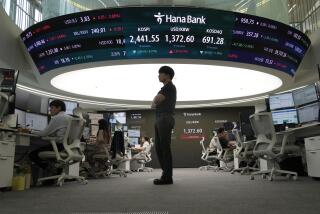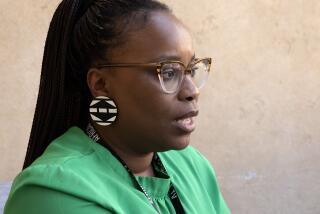U.S., South Korea in a Cinema War
PUSAN, South Korea — When the movie “Fatal Attraction” premiered in South Korea in 1988, the loudest screams came not when the jilted lover played by Glenn Close popped out with a butcher knife but when live snakes slithered under the feet of moviegoers.
The snakes were blamed on South Korean film distributors protesting the first direct distribution of an American film.
Ever since, the real action in the film industry here has been behind the scenes. The plot boils down to a simple formula of the home team versus the outsiders, with the antagonists being South Korean actors and directors who fear they will be wiped out by Hollywood. Far from settling down, the hissing match turned into an epic drama spanning decades and continents.
Filmmakers are angry at what they see as undue pressure by the United States to open the market to more Hollywood films. The current issue is a South Korean law requiring that cinemas show homegrown movies 146 days a year.
The U.S. has repeatedly made it clear that it considers the screen quota a trade barrier and one of the biggest obstacles to free trade agreements between the countries. Hollywood considers South Korea to be one of its more lucrative foreign markets. South Koreans typically have a major presence at the American Film Market, a movie bazaar to be held next month in Santa Monica where foreign film buyers shop for rights.
The quota issue is expected to come up again when President Bush attends the Asia-Pacific Economic Conference, to be held in this port city Nov. 18-19.
In a dress rehearsal for protests to come, filmmakers railed against the U.S. at this month’s Pusan International Film Festival, the largest annual industry event in Asia.
A South Korean lobbying group calling itself the Coalition for Cultural Diversity in Moving Images released a feature-length documentary (called “Fatal Attraction” in reference to the infamous snake incident) that in conspiratorial tones worthy of Michael Moore covered subjects including Henry Kissinger and McDonald’s in an attack on American cultural imperialism.
At a cafe, filmmakers from as far away as France and Iran joined forces with their South Korean counterparts to support the screen quota.
“We don’t think film should be traded like any other commodity. It’s not a car or a ship; it’s our culture,” said Yim Soon Rye, who directed the quirky cult film “Waikiki Brothers” (2001), about a struggling rock band.
U.S. Trade Representative Rob Portman last month described the screen quota, along with a beef-import ban imposed in 2003 after the discovery of the first U.S. case of mad cow disease, as the biggest impediment to a bilateral free trade agreement with South Korea.
“It is somewhat of a symbolic issue as to whether Korea as a newly developed country is willing to take the world stage and make adjustments that might not be popular within small groups within Korea,” said an official with the trade representative’s office, speaking on condition of anonymity.
In Seoul, the U.S.-Korea Business Council and the American Chamber of Commerce issued a policy paper in September that put the screen quota on the top of the list of trade issues between the countries.
“Immediate action would send an important signal of Korea’s commitment to open markets” in advance of the economic conference, the paper said.
Opponents of the screen quota contend that the South Korean film industry no longer needs the crutch to compete.
South Korean pop culture is such a phenomenon in neighboring Asian countries that headline writers are calling it “Kim-Chic.” Hollywood producers have been snapping up remake rights for the most popular South Korean films.
Last year homegrown hits such as “Taegukgi,” a South Korean War epic, and “Silmido,” a Cold War thriller, gave South Korean films a 54% share of the country’s $850 million in box-office sales, according to statistics from the Korean Film Council. The share for American films was 41%.
“They’ve got good acting, good stories,” said Frank Rittman, vice president for the Asia-Pacific region for the Motion Picture Assn. of America. “They should be proud of what they’ve got. We’re not trying to make enemies with them. We are looking for co-production opportunities wherever we can.”
The trade association is asking South Korea to lower the requirement to show domestically made movies to 20% of the time from the current 40%.
Han Duck Soo, South Korea’s deputy prime minister for finance and economy, said in the U.S. last month that “we have to exchange views and opinions about whether there is any other system to replace the current one.”
But the government has treaded cautiously on the screen quota, well aware that it is an emotional issue that can elicit theatrical reactions, to say the least. In 1999, the last time the government made a serious effort to change the quota, hundreds of actors and directors camped out in front of Seoul’s City Hall with shaved heads, and shadowy extremist groups threatened to blow up movie theaters.
To a large extent, South Korea has become a cause celebre in a larger international campaign. The quota has received strong support from France and Canada, among others.
This month the United Nations Educational, Scientific and Cultural Organization voted overwhelmingly in Paris to adopt a convention aimed at promoting cultural diversity that would exempt movies from free trade agreements. U.S. officials and Hollywood studios objected, calling the measure protectionism that could lead to unfair restrictions on U.S. films shown in foreign markets.
South Korean actor Ahn Sung Ki, who is leading the movement to retain the screen quota, credits the vibrancy of his country’s film industry to the nurturing effect of the quota.
He says the U.S. is pushing so hard because it is afraid of a domino effect of other countries enacting restrictions on Hollywood films.
“The United States fears that South Korea will set an example of a country that succeeds in maintaining its own film culture and that other countries will follow us,” Ahn said.
He said the output and quality of Mexican cinema suffered badly after the country reduced its screen quota as part of the North American Free Trade Agreement.
In Asia, Japan and Hong Kong are the most open markets for American film. Despite its entry into the World Trade Organization, China places strict limits on the way foreign films can be distributed.
Polls show that the South Korean public favors keeping the screen quota at its current level. But the feeling is not universal, particularly among some die-hard art-house fans.
Kwon Bo Ra, 22, a medical student who had just come out of a screening of a French film at the Pusan film festival, said the high screen quota squeezed out all but South Korean films and the most commercial Hollywood offerings.
“In the past, I thought quotas were a good idea. Now Korean films are better and more popular so I don’t think we need a quota,” said Kwon, who sees about 10 films a month. “Without it we would get more variety. European films especially.”
More to Read
The biggest entertainment stories
Get our big stories about Hollywood, film, television, music, arts, culture and more right in your inbox as soon as they publish.
You may occasionally receive promotional content from the Los Angeles Times.










